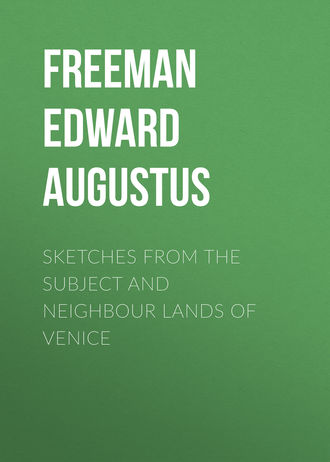
Freeman Edward Augustus
Sketches from the Subject and Neighbour Lands of Venice
The voyage from New to Old Ragusa is not a long one. A shorter land journey on the same side of the city will lead to the sea-side village of Breno, which will not supply the traveller with anything in the antiquarian line, but which will reward him with a good deal of Dalmatian mountain and land scenery, especially with a waterfall, though one not quite on the scale of Kerka. And, to those who peer pryingly into all corners, the little inn of the place will suggest some memories of very modern history. That piece of history it has been the interest of exalted personages to keep unknown, and their efforts have been crowned with a remarkable degree of success. As the inn at Curzola contains picture memories of an unsuccessful struggle for freedom in 1848, so the inn at Breno contains picture memories of a more successful struggle waged twenty-one years later in the same cause and against the same enemy. When in 1869 the present ruler of Austria and Dalmatia strove, in defiance of every chartered right and every royal promise, to trample under foot the ancient rights of the freemen of the Bocche di Cattaro, the troops of the foreign intruder were driven back in ignominious defeat by the brave men of the mountains, and the master who had sent them was forced to renew the promises which he had striven to break. People still chatter about the mythical exploits of Tell, but hardly any one has heard of this little piece of successful resistance to oppression done only twelve years back. The deed is not forgotten by the neighbours of those who did it, and in the inn at Breno rude pictures may be seen showing the victorious Bocchese driving the troops of the stranger down those heights which at Vienna or at Budapest it seemed so easy a matter to bring into bondage. Strange to say, the pictures which record this Slavonic triumph have the legend beneath them in the High-Dutch tongue. Stranger still, it is the eye only and not the ear by which any knowledge of the matter is to be picked up. The wary native, even when spoken to in his own tongue, will not enlarge on the subjects of those pictures to a man in Western garb. It is perhaps not without reason if a stranger in Western garb is suspected in those parts to be a spy of the enemy.
If the voyage from New to Old Ragusa is not a long one, the sail on the other side of the city up the river's mouth to Ombla is shorter still. Its starting-point will be, not Ragusa itself but its port of Gravosa. Here the main object is scenery; but several houses, one at least of which will deserve some further mention, a nearly forsaken monastery with a good bell-tower and a not ungraceful church, and one or two living or forsaken chapels may be taken in, and they help us to complete some inferences as to the architecture of the district. But our business at this moment is mainly with the basin which lies at the foot of the limestone rock. The hills of Greece and Dalmatia constantly suggest, to one who knows the West of England, the kindred, though far lowlier, hills of Mendip. As the gorge under the akropolis of Mykênê at once suggests the gorge of Cheddar, so the basin of the Trebenitza at Ombla suggests, though the scale is larger, the basin of the Axe at Wookey Hole. The river runs out from the bottom of the rocks, and, to those who have been adventurous enough to cross the heights and to make their way through the desolate land of Herzegovina – the very land of limestone in all forms – as far as Trebinje, the river that reappears at Ombla is an old friend. There seems no doubt that it is the Trebenitza which, after hiding itself in a katabothra, comes out again to light in the Ombla basin. The journey to Trebinje itself is in its own nature less exciting now than it was in 1875. What it was when the drive thither from Ragusa enabled the traveller to say that he had been into "Turkey," and that he had seen a little of a land in a state of warfare, may perhaps be worth some separate mention. At present it is reported that Trebinje is cleaner than it was then, that it has been adorned with a Rudolfsplatz, and that justice is there administered to its Slavonic folk, Christian and Mussulman, in the tongue of which Rudolfsplatz is a specimen. It would therefore seem that the direct rule of the stranger is at least better than his "administration." At Ragusa men are allowed to speak their own tongue in which they were born.
RAGUSAN ARCHITECTURE
1875 – 1877 – 1881
We have spoken in a former article of the general aspect and the historical position of the city and commonwealth of Ragusa, her hills, her walls, her havens, her union of freedom from the lion of Saint Mark with half dependence on the crescent of Mahomet. But this ancient and isolated city has yet something more to tell of. There are several of the municipal and domestic buildings of the fallen republic, buildings which, as far as we know, have never been described or illustrated in detail in any English work, and of which no worthy representation can be found on the spot. In the work of Eitelberger much will be found; but for the ordinary English student there is no help at all. Yet, on the strength of these buildings, Ragusa may really claim a place among those cities which stand foremost in the history of architectural progress. And this fact is the more remarkable, and the more to be insisted on, because of the seemingly general belief that there is little or nothing to see at Ragusa in the way of architecture. But the truth is that far more of the old city escaped the earthquake of 1667 than would be thought at first sight. Because the cathedral is later, because the general aspect of the main street is later, the idea is suggested that nothing is left but the municipal palace. That alone would be a most important exception, but it is by no means the only one. If the traveller leaves the main street and turns up the narrow alleys which run from it up the hills on either side, alleys many of them which, at present at least, lead to nothing, he will find many scraps of domestic architecture which must belong to times earlier than the great blow of the seventeenth century. Signs of that blow are seen in many places in the form of scraps of detail of various kinds irregularly built up in the wall; but there are a great number of pointed doorways still in their places which no man can think are later than 1667. Some of these are simply pointed; others combine the pointed arch with the tympanum, sometimes with both the tympanum and the spandril. There is also a not unpleasing type of Renaissance doorway, a lintel resting on two pilasters with floriated capitals, which one can hardly believe are due to a time so late as the days after the earthquake. At all events, if they are later than the earthquake, they only go to strengthen the general position which we have to lay down, namely the way in which early forms lived on at Ragusa to an amazingly late date. This same examination of the narrow streets will also bring to light a few, but only a few, windows of the Venetian Gothic. The strength of Ragusa, as far as scraps of this kind are concerned, undoubtedly lies in its doorways.

TOWER OF FRANCISCAN CHURCH, RAGUSA.
In the churches too there is more left than the mere scraps which are built up again. Parts at least of the tall towers – neither of them detached – of the Franciscan and Dominican churches, the former in the main street, the latter near the eastern gate, are also earlier. In the former the line of junction between the older tower and the ugly church which has been built up against it is clearly to be seen. The upper stage of this tower, and the small cupola which crowns it, may be later than the earthquake; but if so, they have caught the spirit of earlier work in an unusual degree, and all the lower part is in a form of Italian Gothic less unpleasing than usual. Both this tower and that of the Dominican church show how long the general type of the earliest Romanesque campaniles went on. Save in the small cupola, this tower has the perfect air, and almost the details, of a tower of the eleventh century: three ranges of windows with mid-wall shafts rise over one another; only they are grouped under containing arches in what in England we should call a Norman fashion. But, as this tower forms part of a Dominican monastery, it cannot be earlier than the thirteenth century, and its smaller details also cannot belong to any earlier date. Yet the general effect of this tower, even more than of the other, is that of a tower of the Primitive type. The Dominican church also keeps some details of Italian Gothic which must be older than the earthquake, and the cloister is one of the best specimens of that style. Its groupings of tracery under round arches, the poverty of design in the tracery itself, strike us as weak, if our thoughts go back to Salisbury or to Zürich; but the general effect is good, and the cloister – as distinguished from the buildings above it – may almost be called beautiful. Of more importance in the history of Ragusan architecture is the Franciscan cloister. Being Franciscan, it cannot be earlier than the thirteenth century, and it may well be much later. But it is essentially Romanesque in style. The general effect of the tall shafts which support its narrow round arches differs indeed a good deal from the general effect of the more massive Romanesque cloisters to which we are used elsewhere. But it is essentially one with them in style, and it is one of the many witnesses to the way in which at Ragusa early forms were kept in use till a late time.
But the architectural glory of Ragusa is certainly not to be looked for among its churches. The most truly instructive work that Ragusa has to show in any of its ecclesiastical buildings does not show itself at first sight, and its full significance is not likely to be understood till the civic and domestic buildings of the city and its suburbs have been well studied. When this has been done, it will be easily seen that certain arches and capitals in the subordinate buildings of the Dominican church have their part in the history of Ragusan art; but the great civic buildings must be seen and mastered first. Of these two of the highest interest escaped the common overthrow. They both show the Italian Gothic in its best shape; but they also show something else which is of far higher value. They show that peculiar form of Renaissance which can hardly be called Renaissance in any bad sense, which is in truth a last outburst of Romanesque, a living child of classical forms, not a dead imitation of them. Examples of this kind often meet us in Italy; we see something of it in the north side of the great piazza at Venice as compared with the southern side; but the Ragusan examples go beyond anything that we know of elsewhere. Give the palace of Ragusa – the palace, not of a Doge, but of a Rector – the same size, the same position, as the building which answers to it at Venice, and we should soon see that the city which so long held her own against Venice in other ways could hold her own in art also. The Venetian arcade cannot for a moment be compared to the Ragusan; the main front of the Ragusan building has escaped the addition of the ugly upper story which disfigures the Venetian. As wholes, of course no one can compare the two in general effect. Saint Blaise must yield to Saint Mark. But set Saint Blaise's palace on Saint Mark's site; carry out his arcade to the same boundless extent, and there is little doubt which would be the grander pile. The Venetian building overwhelms by its general effect; the Ragusan building will better stand the test of minute study.

PALACE, RAGUSA.
The palace of the Ragusan commonwealth was begun in 1388, and finished in 1435, in the reign, as an inscription takes care to announce, of the Emperor Siegmund. What name shall we give to the style of this most remarkable building, at all events to the style of its admirable arcade? Here are six arches – why did not the architect carry on the design through the whole length of the building? – which show what, as late as the fifteenth century, a round-arched style could still do when it followed its natural promptings, instead of either binding itself by slavish precedents or striving after a helpless imitation of foreign forms. Never mind the date; here is Romanesque in all its truth and beauty; here, in the land which gave Rome so many of her greatest Cæsars, the arcade of Ragusa may worthily end the series which began with the arcades of Spalato. Siegmund, the last but one to wear the crown of Diocletian in the Eternal City, has his name not quite unworthily engraved on a building less removed in style than a distance of more than eleven centuries would have led us to expect from the everlasting house of Jovius. Does some pedantic Vitruvian brand the columns as too short? The architect has grasped the truth that, as the arch takes the place of the entablature, the height of the arch may fairly be taken out of the height of the column. Does he blame the massive abaci? They are wrought to bear the greater immediate weight which the arch brings upon the capital, and they avoid such shifts as the Ravenna stilt and the Byzantine double capital. Does he blame the capitals, which certainly do not follow the exact pattern of any Vitruvian order? Let us answer boldly, Why should art be put in fetters? A Corinthian capital is a beautiful form; but why should the hand of man be kept back from devising other beautiful forms? The Ragusan architect has ventured to cover some of his capitals with foliage which does not obey any pedantic rule; in others he has ventured – like the artists of the noble capitals which may still be seen in the Capitol and in Caracalla's baths – to bring in the forms of animal and of human, as well as of vegetable, life. In one point his taste seems slightly to have failed him; on some of the capitals the winged figures with which they are wrought savour a little of the vulgar Renaissance. But who shall blame the capital long ago engraved and commented on by Sir Gardner Wilkinson, in which however a neighbouring inscription shows that tradition was right in seeing the form of Asklêpios, and not that of a mere mortal alchemist, though tradition was certainly wrong in believing that Asklêpios had been brought ready made from his old home at Epidauros? And the capitals bear arches worthy of them, round arches with mouldings and ornaments, which thoroughly fit their shape, though, like the capitals, they do not servilely follow any prescribed rule. Altogether this arcade only makes us wish for more, for a longer range from the same hand. Compare it with the vulgar Italian work of the two neighbouring churches. Pisa and Durham might have stretched out the right hand of fellowship to Romanesque Ragusa before the earthquake; they would have held it back from Jesuited Ragusa after it.
The rest of the front cannot be called worthy of this admirable arcade. The windows behind the arcade are of the worse, those above it are of the better, kind of Italian Gothic. These last in fact are about as good as Italian Gothic can be. They are well proportioned two-light windows with Geometrical tracery, and in the general effect they really agree better than could have been looked for with the admirable arches below. Still they are Italian Gothic, and at Ragusa we should not welcome the loveliest form of tracery that Carlisle or Selby could give us. A Pisan arcade, pierced for light wherever light was wanted, would have been the right thing for the columns and arches to bear aloft. He who duly admires the arcade will do well to shut his eyes as he turns round the corner by the west front of the cathedral; but let him go inside, and the court, if not altogether worthy of the outer arcade, is no contemptible specimen of the same style. It contains one or two monuments of Ragusan worthies. The figure of Roland, which lay there neglected when we first saw Ragusa, has since been set up again in the open piazza. And, strange to say in these lands, it ventures to proclaim itself as having been set up, as it might have been in the old time, by the free act of the commune of Ragusa, without any of those cringing references to a foreign power which are commonly found expedient under foreign rule. The court is entered by a side door with two ancient knockers, one of them a worthy fellow of the great one at Durham or of that which we saw more lately at Curzola. But its chief interest comes from its strictly architectural forms, and from the comparison of them with those which are made use of on the outside. The court is very small, and it is surrounded on all sides, save that which is filled by the grand staircase, by an arcade of two, supporting a second upper range. The composition is thus better than that of the front itself, as there are two harmonious stages in the same style, without any intrusion of foreign elements, like the pointed windows in the front; but the arcades themselves, though very good and simple, do not carry out the wonderful boldness and originality of the outer range. Columns with tongues to their base with flowered capitals, showing a remembrance, but not a servile remembrance, of Corinthian models, support round arches. Over these is the upper range of two round arches over each one below, resting on coupled shafts, the arrangement which, from the so-called tomb of Saint Constantia, has spread to so many Romanesque cloisters and to so many works of the Saracen. Were this range open, instead of being foolishly glazed, this design of two stages of a true Romanesque, simpler, but perhaps more classical, than the outer arcade, would form a design thoroughly harmonious and satisfactory.
Now when we come to examine this inner court more minutely, we shall find that it is certainly of later date than the outer arcade, and that it supplanted earlier work which formed part of the same design as the outer arcade. It is impossible to believe that the court is later than the great earthquake; but 1667 was not the only year in which Ragusa underwent visitations of that kind; and it is an allowable guess that a rebuilding took place after an earlier earthquake in the beginning of the sixteenth century. That some change took place at some time is certain. There are preparations for spanning arches at one point of the outer wall of the court, which could never have agreed with the position of the present columns. And we have a most interesting piece of documentary evidence which carries us further. In a manuscript account of the building of the palace, it is mentioned that at the entrance were two columns, on the capital of one of which was carved the Judgement of Solomon, while the other showed the Rector of Ragusa sitting to administer justice after the model of Solomon. Now this cannot refer to the outer arcade, where none of the capitals show those subjects. Still less is there anything like it in the arcade of the court, nor can there have been since the present arrangement was made. But the description is no freak of the imagination; both capitals are in being; one of them is still within the palace. The capital showing the Rector in his chair dispensing justice to his fellow-citizens is built in at a corner in the upper story of the court. And a capital of exactly the same style, and with the Judgement of Solomon carved on one face of it, may still be seen in the garden of a house outside the city of which we shall have presently to speak. It is thus perfectly plain that the inner court was rebuilt at some time later than the days of Siegmund, and that this rebuilding displaced an inner design more in harmony with the outer arcade, and of which these two capitals formed a part.
To our mind this palace, to which Sir Gardner Wilkinson hardly does justice, and of which Mr. Neale takes no notice at all, really deserves no small place in the history of Romanesque art. It shows how late the genuine tradition lingered on, and what vigorous offshoots the old style could throw off, even when it might be thought to be dead. One or two capitals show that the Ragusan architect knew of the actual Renaissance. But it was only in that one detail that he went astray. In everything else he started from sound principles, and from them vigorously developed for himself. And the fruit of his work was a building which thoroughly satisfies every requirement of criticism, and on which the eye gazes with ever increased delight, as one of the fairest triumphs of human skill within the range of the builder's art.
But the palace must not be spoken of as if it stood altogether alone among the buildings of the city. There is another civic building, which, though it does not reach the full perfection of its great neighbour, must also be treated as a true fruit, in some sort a more remarkable fruit, of the same spirit which called its greater neighbour into being. This is the building which acted at once in the characters of mint and custom-house, the second character being set forth by its name wrought in nails on the great door. This building stands just where the main street and the piazza join, close by the arch leading to the town-gate. Here we have an arcade of five, the columns of which are crowned with capitals, Composite in their general shape, but not slavishly following technical precedents, nor all of them exactly alike. They have a heavy abacus, which, as well as the soffit of the round arch, is enriched with flowered work. One or two of them are none the better for being new chiselled in modern times. Here is something which is quite unlike Northern Romanesque, but which still is absolutely identical with it in principle. The column and the round arch are there in their purity, and the enrichment is of a kind which we instinctively feel is in place at Ragusa, though it would be out of place at Caen or Mainz or Durham. Whatever the date may be, the thing is thoroughly good, incomparably better than either the Italian Gothic or the cosmopolite Jesuit style. Above the arcade are windows with the usual Venetian attempt at tracery, a large square window between two with ogee arches; above is a stage with square windows, which we may hope is a later addition. The merits of the three stages lessen as they get higher. Yet from the date, when we come to find it out, it seems not impossible that the arcade and both the stages above it may really be of the same date. In the inner court there are no such discordant elements as there are without, though the forms of different styles are quite as much mingled. Octagonal piers support round arches; pointed doorways with thoroughly Ragusan tympana open into the chamber behind them. On this arcade rests another, with round arches on the short sides of the court, and pointed arches on the long sides, rising from columns and square piers alternately. Above is a range which might as well be away. Square windows, round Ragusan windows, might well be endured; but Renaissance shields and Renaissance angels show that the infection had begun. Now this beautiful piece of Romanesque work – we give it that name in defiance of dates – was finished in 1520, when the world on the southern side of the Alps was, for the most part, running after the dreariest forms of the mere revived Italian. This amazingly late date makes this building even more wonderful than the palace, though it certainly is not its rival in beauty. The arcades, good as they are, cannot be compared to those of the palace, and the Venetian work above is still more inferior. Still, the later the date, the more honour to the architect who designed such a work at such a time. And the later the date, the more likely that he built his arcade according to the promptings of his own genius, and added the two ranges of windows in deference to the two rival fashions of his time.

DOGANA, RAGUSA.
The arcade of this building, taken alone without reference to the windows above, is the last link in a chain which shows that the preservation of good architectural ideas at so late a time is no mere accident. Indeed, if we pass from public buildings within the city to private buildings outside of it, we shall begin to doubt whether the dogana is the last chain, and whether there are not still later buildings which are fairly entitled to the Romanesque name. The best of the houses of the Ragusan patricians are to be found, not within the city, but by the port at Gravosa, and further on on the way to Ombla. Several of those, while their other features are Venetian Gothic, or even later still, have – commonly in their upper loggie– a column or two supporting a round arch, which are certainly not vulgar Renaissance, and which keep on the sound tradition of the palace and the dogana. The finest of these is the house of the Counts Caboga, known as Batahovina, on the coast on the way to Ombla. Here, as in the palace, as in the dogana, an arcade of this late local Romanesque supports an upper story of Venetian Gothic, very inferior and most likely much later than that in either of the civic buildings. It has however at each end an open loggia matching the arcade below. The columns, plain and with twisted flutes – distant kinsfolk of Waltham, Durham, Dunfermline, and Lindisfarn – have capitals such as we might look for in much earlier Romanesque.

CABOGA HOUSE, GRAVOSA.
This, we may note by the way, is the house in whose garden the column from the palace, wrought with the Judgement of Solomon, still lies hid. Indeed we might go further away from the palace than the loggie of the houses. At Ragusa art extends itself to objects which might have been thought hardly capable of artistic treatment. Stone is common, and it is used for all manner of purposes. Among other things stone vine-props are common. In not a few cases these take the form of columns, slenderer doubtless than the rules of classical proportion, realizing the description of Cassiodorus about the tall columns like reeds, the lofty buildings propped as it were on the shafts of spears. Sometimes the columns are fluted or twisted; in a great many cases they have real capitals, with various forms according to taste. It often happens that a row of such columns, whether on a house-top or in a vineyard, really becomes an architectural object, a genuine colonnade. Here the style, the construction at least, is Greek rather than Romanesque; but the principle is the same. A good and rational artistic form is kept in use, and is applied to a purpose for which it is fitted.
All these examples, the palace, the dogana, the houses, the remains in the Dominican church, we might almost say the vine-props, look one way. All point to the existence of a Ragusan style, to an unbroken Romanesque tradition, which could not wholly withstand the inroads of the pseudo-Gothic of Italy, but which could at least keep its place alongside of the intruder. All help us to see how instructive must have been the course of architectural developement at Ragusa, and how much has been lost to the history of art by the destruction of so many of the buildings of the city in the great earthquake. It is easy to see that for a long time the struggle between the genuine Romanesque tradition, the Italian Gothic, and the new ideas of the Renaissance, must have been very hard. How long real Romanesque went on, bringing in new developements of its own, but remaining still as truly Romanesque by unbroken succession as anything at Pisa or Durham, is shown by the noble arches of the palace, and the still later dogana. The slight touch of Renaissance in some of the capitals of the palace in no sort takes away from the general purity of the style. Still over these noble arcades are windows of Venetian Gothic, and one of the most characteristic features of the Ragusan streets are the flat-headed doorways. But these, alternating as they do with pointed ones, help to make out our case. On the other hand, it is equally plain that in some cases the Renaissance came in early. A little chapel by the basin at Ombla, bearing date 1480, is in a confirmed Renaissance style, and looks more like 1580. Yet of true Renaissance there is very little. One large house in the city, older than the earthquake, stands quite alone as the kind of thing which might easily have been built in Italy or copied in England. But at Ragusa, in the near neighbourhood of several native doorways of different shapes, of many native vine-props, of several native wells – for wells too take an artistic style and copy the form of a capital – the regular trim Palladian building looks strangely out of place. Even in the Stradone, where in the houses there is little architecture of any kind, a touch of ancient effect is kept in the form of the shops, with their arches and stone dressers, thoroughly after the mediæval pattern. And some architectural features never died out. The round window with tracery goes on long after every other feature of Romanesque or Gothic is forgotten. It is to be seen in endless little chapels of very late date in the city and suburbs, sometimes standing apart, sometimes attached to private houses.
The plain conclusion from all this is that at Ragusa the use of the round arch for the chief arcades never went out of use; that it always remained as a constructive feature, passing from Romanesque to Renaissance, if fully developed Renaissance can at Ragusa be said to exist at all, without any intermediate Gothic stage, and continuing to invent and adopt any kind of ornament which suited its constructive form. In windows and doorways, on the other hand, the forms of the Italian Gothic came in and stood their ground till a very late date. In most cases we wish the Venetian features away; in the upper story of the palace they may be endured; but conceive palace, dogana, Caboga house, with smaller arcades and windows to match the great constructive arches. Such buildings as these, now so few, make us sigh over the effects of the great earthquake, and over the treasures of art which it must have swallowed up. If Ragusa, in her earlier day, contained a series of churches to match her civic arcades, she might claim, in strictly artistic interest, to stand alongside of Rome, Ravenna, Pisa, and Lucca. Her churches of the fifteenth century must have been worthy to rank with anything from the fourth century to the twelfth. One longs to be able to study the Ragusan style in more than these few examples. It is not indeed absolutely peculiar either to Ragusa or to Dalmatia. Many buildings in Italy and Sicily show a good native Romanesque tradition, holding its own against the sham Gothic, and showing a good fight against the Renaissance. Not a few arcades, not a few cloisters, of this kind may be found here and there. But it would be hard to light on another such group of buildings as the palace, the dogana, and their fellows. In any case the Dalmatian coast may hold its head high among the artistic regions of the world. It is no small matter that the harmonious and consistent use of the arch and column should have begun at Spalato, and that identically the same constructive form should still be found, eleven ages later, putting forth fresh and genuine shapes of beauty at Ragusa.







